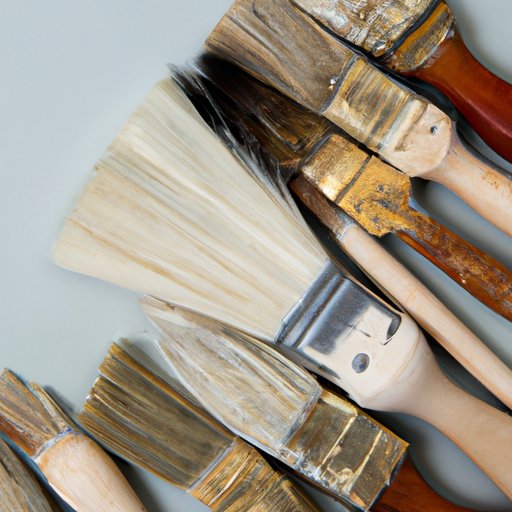
Introduction
Cleaning your paintbrushes is an essential part of maintaining their quality and longevity. Properly cleaned and cared for brushes maintain their shape, bristle texture, and overall performance. When you invest in quality brushes, taking good care of them ensures that you get the most out of your investment. In this guide, we’re going to cover tips and techniques for cleaning your brushes, including quick and easy cleaning methods, DIY solutions, and tips for professional artists.
The Ultimate Guide to Cleaning Your Paintbrushes
Tips for cleaning oil-based vs. water-based paints
When cleaning your brushes, the type of paint you use makes a difference. For oil-based paints, use mineral spirits or turpentine. For water-based paints, use a mild soap and warm water. Avoid using hot water as it can damage the bristles of your brushes.
Importance of using the right cleaners
Using the right cleaners for your brushes can make a significant difference in their longevity and overall performance. Use a cleaner that is specifically formulated for the type of paint you use. Avoid using harsh chemicals or cleaners that are not meant for brushes.
Guidelines for storing brushes after cleaning
After cleaning your brushes, make sure to store them properly to prevent damage. Reshape the bristles and let them dry completely before storing them. Avoid storing your brushes in airtight containers as this can trap moisture and grow bacteria. Store them in a cool, dry place, preferably in a brush holder, to maintain their shape.
Quick and Easy Brush Cleaning Techniques
Overview of time-efficient cleaning methods
For a quick cleaning, use a paper towel or rag to remove excess paint from the brush. Then, run the brush under lukewarm water until the water runs clear. Gently massage the bristles with your fingers to remove any remaining paint.
Recommendation of specialized cleaning tools
Using specialized cleaning tools, such as a brush-cleaning pad or mat, can make cleaning your brushes even easier. These tools are specifically designed to remove paint from your brushes and are easy to clean.
Demonstration of the brush-cleaning glove
The brush-cleaning glove is a quick and easy way to clean your brushes. Simply slip it over your hand and massage the bristles with soap and water. The textured surface of the glove helps to clean the brushes thoroughly.
DIY Brush Cleaning Solutions that Work
Introduction to simple ingredients for homemade cleaning solutions
You can make your own cleaners using simple ingredients you may already have on hand. Homemade cleaners are often gentler and safer for your brushes and save you money in the long run.
Description of how to make vinegar-based brush cleaner
A vinegar-based brush cleaner is effective for removing paint and safe for your brushes. Mix equal parts white vinegar and warm water in a cup or jar, and soak the brush for 30 minutes. Rinse thoroughly, reshape, and let it dry completely.
Demonstration of how to use baking soda as a brush cleaner
Baking soda is a safe and effective cleaner for brushes. Mix equal parts baking soda and warm water in a bowl to create a paste. Coat the bristles with the paste and use your fingers to massage it in. Rinse thoroughly, reshape, and let it dry completely.
The Dos and Don’ts of Brush Cleaning
Explanation of common mistakes to avoid when cleaning brushes
Avoid using hot water, as it can cause the bristles to break down and lose their shape. Also, avoid using harsh cleaners or leaving the brushes to soak for too long.
Highlighting the importance of using lukewarm water and cleaning brushes regularly
Use lukewarm water and a gentle cleaner to prevent damage to the bristles. Cleaning your brushes regularly, after each use, helps to prevent paint from building up and hardening in the bristles.
Description of gentler and safer cleaning methods for brushes
Gentler and safer cleaning methods include using a mild soap and warm water to clean your brushes, or soaking them in a vinegar and water mixture. Use a soft-bristled brush or your fingers to massage the bristles, rather than a wire brush or comb, which can damage the bristles.
Proper Brush Cleaning for Professional Artists
Specialized tips for professional artists or high-end brushes
Professional artists or those using high-end brushes may require specialized cleaning techniques. Use a deep cleaning solution, such as Winsor & Newton Brush Cleaner, to remove stubborn paint buildup.
Explanation of how to handle and spot-treat stubborn stains
For stubborn stains, use a mixture of 50% vinegar and 50% water and soak the brush for several hours. Gently massage the bristles until the stain lifts.
Tips for maintaining brush shape and extending lifespan of brushes
To maintain the shape of your brushes, avoid pressing down too hard, twisting the brush, or resting it on the bristles. After cleaning, reshape the bristles and let them dry completely before storing them.
Conclusion
Recap of key points covered in the article
Cleaning your paintbrushes regularly is essential for maintaining their quality and longevity. Use the right cleaners, store brushes properly, and use gentle cleaning methods to avoid damaging the bristles.
Emphasis on the importance of properly cleaning brushes
Taking care of your brushes not only ensures better performance but also extends their lifespan, saving you money in the long run.
Encouragement to put tips and techniques into practice
Use the tips and techniques covered in this guide to ensure your brushes are always clean and performing their best.




